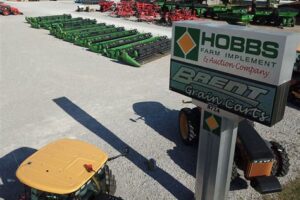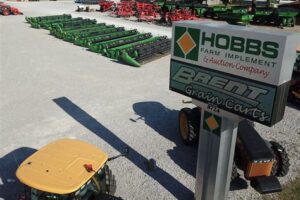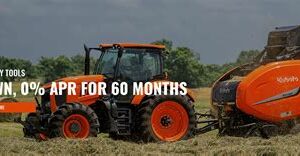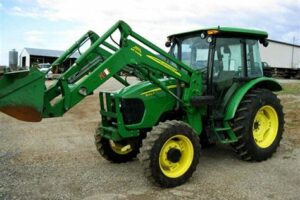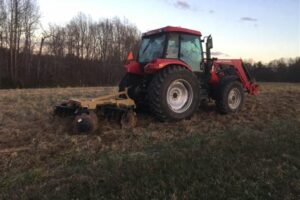Table of Contents
Discover who has the right of way when it comes to farm equipment on the road. Understand the rules and regulations surrounding farm equipment, ensuring safe and efficient travel for all motorists. Learn how to navigate encounters with tractors and other agricultural vehicles to promote road safety and avoid accidents.
When it comes to navigating the roads, we often assume that cars and trucks have the right of way. However, what about farm equipment? These massive machines play a crucial role in our agricultural industry, and their presence on the road is not uncommon. As we encounter tractors, combines, and other farm vehicles, it is essential to question whether they have the same right of way as other vehicles. To explore this topic further, we must consider the various factors that come into play, such as speed limits, signage, and the safety precautions taken by farmers. By delving into these aspects, we can gain a better understanding of whether farm equipment should be given priority on the road and shed light on the potential conflicts that may arise in rural areas.
Introduction
When it comes to sharing the road with farm equipment, questions often arise regarding right-of-way. Farm equipment, such as tractors and combines, are crucial for agricultural operations but can significantly slow down traffic. This article aims to explore the topic of whether farm equipment has the right-of-way on public roads and highways.
Understanding Farm Equipment
Farm equipment refers to vehicles and machinery specifically designed for use in agricultural activities. These can include tractors, harvesters, plows, sprayers, and other specialized tools. Their sheer size and slower speed can pose challenges when they share the road with regular vehicles.
General Rules of the Road
In most jurisdictions, including the United States, farm equipment is subject to the same traffic laws as any other vehicle. This means that they must follow all applicable rules, including stopping at red lights and stop signs, yielding to pedestrians, and staying within speed limits. These rules help maintain order and safety on the roads.
Exceptions and Special Considerations
However, there are exceptions and special considerations when it comes to farm equipment’s right-of-way. Some states have implemented laws that allow farm equipment to temporarily deviate from regular traffic rules. For example, they may be permitted to cross over into the opposite lane briefly to avoid obstacles or when making wide turns.
Impact on Traffic Flow
The slow speed and size of farm equipment can significantly impact traffic flow, especially on narrow roads. When encountering farm equipment on the road, it is essential for other drivers to exercise patience and caution. Attempting to overtake farm equipment in an unsafe manner can lead to accidents and injuries.
Sharing the Road Responsibly
Sharing the road with farm equipment requires cooperation and understanding from all parties involved. Farm equipment operators should display appropriate signage, such as Slow Moving Vehicle emblems, to alert other drivers. They should also pull over when possible to allow traffic to pass safely.
Road Etiquette for Other Drivers
For other drivers sharing the road with farm equipment, it is crucial to follow these guidelines:
1. Keep a Safe Distance:
Maintain a safe following distance when driving behind farm equipment. Their slower speed means they may need to brake suddenly or make unexpected maneuvers.
2. Do Not Overtake Unsafely:
Only attempt to overtake farm equipment when it is safe, legal, and you have a clear view of the road ahead. Avoid overtaking on curves, hills, or other areas with limited visibility.
3. Communicate and Be Patient:
Use your vehicle’s signals to communicate your intentions to the farm equipment operator. Be patient and wait for a safe opportunity to pass when it arises.
Road Safety Measures
To ensure the safety of both farm equipment operators and other drivers, road safety measures can be implemented. These may include widening roads, creating designated passing zones, or establishing alternative routes for farm vehicles.
Raising Awareness
It is essential for authorities and organizations to raise awareness about sharing the road with farm equipment. Educational campaigns can help drivers understand the challenges faced by farm equipment operators and encourage responsible behavior on the road.
Conclusion
Farm equipment shares the road with regular vehicles, and while they must follow traffic laws, there are exceptions and special considerations. Patience, caution, and responsible behavior from all road users are crucial to ensure the safety and efficiency of agricultural operations and general traffic flow. By understanding the challenges faced by farm equipment operators and following road etiquette, we can create a harmonious environment for all on the road.
I. Introduction
Exploring the question of whether farm equipment has the right of way on public roads.
II. Farm Equipment and Public Roads
Farm equipment such as tractors and harvesters are necessary for agricultural activities. They are commonly operated on public roads to transport goods or move between fields. Despite their slow speed and large size, their presence on public roads may raise questions about right of way.
III. Regulations and Laws
Traffic laws often determine right of way on public roads, but they may not specifically address farm equipment. Different regions and countries may have varying rules regarding farm equipment on roads. Understanding these regulations is essential for both farm equipment operators and other road users.
IV. The Slow-Moving Vehicle Emblem
Farm equipment vehicles often display a triangular, fluorescent orange emblem with a red border. This emblem indicates that the vehicle is slow-moving and may require additional caution from other road users. It serves as a visual warning and helps in identifying farm equipment entitled to certain rights on the road.
V. Farm Equipment on Narrow and Two-Lane Roads
Farm equipment may be wider than the average vehicle, making it challenging for passing on narrow roads. In these situations, farm equipment usually has the right of way, and other vehicles should wait for a safe opportunity to pass. Two-lane roads require farm equipment to stay as far to the right as possible to allow other vehicles to pass.
VI. Yielding to Emergency Vehicles
In emergency situations where emergency vehicles need to pass farm equipment, it is crucial for farmers to yield and allow them to overtake promptly. Acting quickly and responsibly ensures the safety of all parties involved. Farm equipment operators should be aware of their surroundings and prepared to yield when necessary.
VII. Accommodating Farm Equipment
Road users should be patient when encountering farm equipment on the road, as their travel speed is typically slower. Maintaining a safe distance is vital, especially when visibility is limited due to dust, weather conditions, or equipment size. Being respectful and understanding of the importance of agriculture helps promote harmonious coexistence on the road.
VIII. Proper Communication and Cooperation
Good communication between farm equipment operators and other road users is key to ensuring safe interactions. Using appropriate signals, recognizing hand gestures, and maintaining eye contact can help in these situations. By working together, all parties can navigate shared roads successfully and minimize potential conflicts.
Point of View: Does Farm Equipment Have The Right Of Way
As a professional in the agricultural industry, it is important to understand the rules and regulations surrounding farm equipment on the roads. One common question that often arises is whether farm equipment has the right of way. Below are some key points to consider:
-
Farm equipment’s right to use public roads: Farm equipment, such as tractors, combines, and other agricultural machinery, are essential for carrying out farming operations. In many jurisdictions, farm equipment is legally allowed to use public roads to access fields or move between different areas. This acknowledgment recognizes the importance of efficient and timely agricultural activities.
-
Slow-moving vehicles: It is crucial to note that farm equipment typically operates at much slower speeds compared to regular motor vehicles. This can result in traffic delays and frustration among other road users. However, it is important to respect the slow-moving nature of farm equipment and exercise patience when encountering them on the road. Their presence indicates that agricultural work is being conducted, benefiting the community as a whole.
-
Sharing the road safely: Both farmers operating farm equipment and other road users have a responsibility to ensure safe road sharing. Farmers should display appropriate signage, such as reflective triangles or flashing lights, to indicate their presence and alert other drivers. Additionally, they should always stay as far to the right side of the road as possible, allowing faster vehicles to pass when it is safe to do so.
-
Precautions for other road users: For drivers encountering farm equipment on the road, it is important to approach with caution. Keep a safe distance behind the equipment, as sudden stops may be necessary due to the nature of agricultural work. Avoid overtaking unless it is absolutely necessary and can be done safely. Be mindful of the size and width of farm equipment, allowing ample room for safe passing when available.
-
Communication and mutual respect: Effective communication between farmers and other road users is key to ensuring everyone’s safety. Farmers should use appropriate hand signals or indicators to indicate their intentions, such as turning or stopping. Similarly, drivers should use their vehicle’s signals to communicate their movements to the farmer. Mutual respect and understanding are crucial in creating a harmonious environment on the roads.
In conclusion, farm equipment does have the right to use public roads for agricultural purposes. However, it is important for both farmers and other road users to exercise caution, patience, and respect when encountering farm equipment. By adhering to road sharing guidelines and maintaining open lines of communication, we can ensure the safety and efficiency of farming operations while minimizing disruptions for all road users.
Thank you for taking the time to visit our blog and read our article on the topic of whether farm equipment has the right of way. We hope that you found the information provided to be informative and thought-provoking. As we conclude this discussion, it is important to remember that the issue of right of way can vary depending on the specific circumstances and jurisdiction. However, we have aimed to provide a general overview of the topic and shed light on some key considerations.
Throughout the article, we explored the importance of understanding and respecting the rights and responsibilities of different road users, including farmers operating large machinery. While it is true that farm equipment is often slower-moving and bulkier than other vehicles on the road, it is crucial for all parties involved to exercise caution and patience in order to ensure safety and minimize accidents.
Additionally, we discussed how the issue of right of way is not solely determined by the size or speed of a vehicle, but rather by the specific traffic laws and regulations in place. It is essential for both farmers and other drivers to familiarize themselves with these laws to promote harmony and cooperation on the roads. By being aware of the rights and duties of all road users, we can work towards a safer and more efficient transportation system.
In conclusion, the question of whether farm equipment has the right of way is not a simple one. It requires an understanding of the laws and regulations governing traffic in your jurisdiction, as well as a sense of patience and respect for all road users. Ultimately, the goal should be to prioritize safety and to approach situations involving farm equipment with caution and consideration. We hope that this article has provided you with a better understanding of the topic and encourages you to drive responsibly when encountering farm equipment on the road.
Thank you once again for visiting our blog, and we invite you to explore our other articles for valuable insights on various topics related to farming, agriculture, and rural life.
Video Does Farm Equipment Have The Right Of Way
People also ask about whether farm equipment has the right of way in various situations:
-
Do farm vehicles have the right of way on roads?
Answer: In general, farm vehicles do not have automatic right of way on public roads. However, specific rules and regulations may vary depending on local laws and ordinances.
-
Are drivers required to yield to farm machinery?
Answer: Yes, drivers are typically required to yield to farm machinery when necessary for safety reasons. It is important to exercise caution and give farm equipment enough space to operate safely.
-
What should I do if I encounter farm equipment on a narrow road?
Answer: When encountering farm equipment on a narrow road, it is advisable to slow down, maintain a safe distance, and wait for a suitable opportunity to pass. Be patient and ensure you have enough visibility before attempting to overtake.
-
Are there any special considerations when passing farm equipment?
Answer: Yes, when passing farm equipment, it is crucial to allow for extra clearance due to their size and potential debris they may be carrying. Always use turn signals, check for oncoming traffic, and ensure it is safe to pass before doing so.
-
Should I honk or signal to indicate my presence to farm equipment operators?
Answer: While it is not mandatory, it can be helpful to honk or use your vehicle’s signals to indicate your presence to farm equipment operators. This alerts them to your presence and allows them to adjust their operations if necessary.
-
What precautions should I take when sharing the road with farm equipment?
Answer: Some precautions to take when sharing the road with farm equipment include reducing your speed, maintaining a safe distance, being patient, and following any instructions or signals given by the farm equipment operator.

